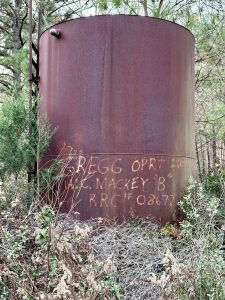Artifacts From The Oil Boom Dot Our Land
Suddenly, it is Christmas.
As usual in this season of my life, the year passes in a blur, hard as I try to relish every day. There is little to be done about the speed in which days go by, except be grateful for all our blessings and try to be kind. And take time to relish the small beauties of this world — frost glistening on tall grass along my morning walk, leaves skittering across the asphalt as the hardwood trees become dormant skeletons.
During this three-week break between semesters, I am working on Three Geese Farm as weather allows. A couple of fierce thunderstorms during late spring and early summer — before the drought set in — sent tree limbs crashing down throughout our 57 acres. I have finally recovered sufficiently from major shoulder surgery to wield a chain saw and begin the laborious — and likely never-ending — process of cutting up the fallen limbs and hauling them to the burn pile. It is in easy reach of a water hose if the grass starts burning, and the fire spreads.
This definitely slows down the progress, since often I am driving the tractor several minutes from out in the woods to the burn pile, but I live in fear of starting a forest fire. Besides, what’s the hurry? The tree limbs are not going anywhere. I listen to Spotify through noise-canceling earplugs as I work, relishing the fact that I am not even breaking a sweat on this last day of autumn.
I took a break from chain-sawing tree limbs when my shoulder started aching and began bushhogging instead on the southwestern piece of the farm, which hasn’t been bushhogged since spring. It gets tricky cutting down tree-high weeds, not exactly knowing what I’m driving into. I mowed one clearing that contains a fiberglass tank that once held something oil related. It has been quite some time since this part was in production, since a 30-foot tree grows out of the middle of the tank.
 About 50 feet away was a large rusty tank about 15-feet high. Years ago, someone had spraypainted Gregg Oprt Inc, W.C. Mackey “B,” RRC# 08672. Our farm once was home to about a dozen oil rigs dating back to the 1930s, according to what one fellow told me. All that is left are the four concrete pillars on which the derricks were anchored. A few times, as I slowly work to tame this property, I have bashed into one of these pillars with the bushhog, since they are hidden in the weeds. That will jar you right out of the tractor seat.
About 50 feet away was a large rusty tank about 15-feet high. Years ago, someone had spraypainted Gregg Oprt Inc, W.C. Mackey “B,” RRC# 08672. Our farm once was home to about a dozen oil rigs dating back to the 1930s, according to what one fellow told me. All that is left are the four concrete pillars on which the derricks were anchored. A few times, as I slowly work to tame this property, I have bashed into one of these pillars with the bushhog, since they are hidden in the weeds. That will jar you right out of the tractor seat.
There is still one working pump jack down behind the shop, the oil horse slowly rocking back and forth as I mowed around it. The large gravel lot at the bottom of the hill behind the house holds a working gas well. About once a month, someone shows up in a pickup and checks the well — for what I have no idea.
I stop and take a gander at Glade Creek, which is up considerably from last summer. At least a dozen pipelines are suspended above the creek, as well as an iron-pipe bridge that got smashed in a previous flood and is unusable — and unfixable. It is nearly impossible to buy any significant piece of property in these parts that doesn’t hold evidence of previous oil and gas exploration, even if it is no longer active.
My bushhogging ends ignominiously when the cutter starts shaking violently. I have plowing through some pretty serious underbrush — saplings an inch or so in diameter. I shut off the tractor and climb off, something I am grateful to still be able to do with ease. When I stop to examine the bushhog, it is obvious something is wrong with the gearbox that turns the blade and is hooked to the PTO. It is oozing grease. When I reach down and shake the box, all four bolts attaching it to the base are very loose. It is time to get little brother Gregg back over, likely right after Christmas, to get it fixed. It is always something with tractors.
|———|
I hope you and yours have a Merry Christmas. Be safe and be kind, and God Bless.
Leave a reply
Fields marked with * are required











